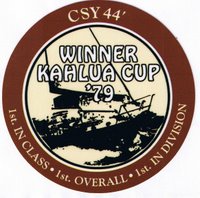|
CSY |
|

|
For Sale |
||
|
CSY Workshop |
||
|
Sailing Photos |
||
|
Interior Photos |
||
|
Deck Photos |
||
|
Cockpit Photos |
||
|
Engine Room Photos |
||
|
CSY Construction |
||
|
Equipment List |
||
|
FAQ's |
||
|
Cruising SE Asia Contact |
||
Initially, CSY contracted with other boatbuilders for the manufacture of their vessels, not for private sale, but for use in their company-owned charter business in the Caribbean. After several unsuccessful attempts to obtain a properly constructed yacht from subcontractors, founder Jack Van Ost decided that the only way he could control the quality of the boats in his fleet was to manufacture them himself.
CSY management refined their designs through client questionnaires and dialogue with charter captains, yacht charter managers and dock masters to compete with rival charter fleets of Morgan Out Islands, Gulfstars and Irwin yachts. The result was a roomy and robust sailboat with emphasis on structural integrity, and designed for the boisterous tradewinds of the Caribbean. The new boat and sail plan well outperformed other boats of a similar size. In 1979, a CSY 44 won overall honors in the Kahlua Cup race sponsored by the St. Pete Yacht Club.
In their heyday, CSY turned out one boat each workday, and produced in the neighborhood of 400 vessels, with approximately 185 boats in the charter fleet. CSY Yachts manufactured a few powerboats, but the vast majority were sailboats; a 33-foot, 37-foot and three versions of a 44-foot, a walkover, walkthrough and pilot house. The walkthrough was added to the line after prospective owners clamoured for an "owner's model" with specific additional features. The walkthrough and pilot house versions sold at a premium over the walkover model designed for the charter business.
CSY
Quality
A CSY Advertisement from a Sailing Magazine in about
1978
The Mold
No part that comes from the mold can be better than the mold itself. It is a truism. And by the same token, no mold can be better than the "plug" from which it was made. Here is the sequence.
From the finished architect's drawing board comes the finished yacht design from which an exact full scale model or "plug" is built. Months go into its preparation. Every mark, every unevenness must be sanded and buffed until a perfectly smooth high gloss finish is achieved. There can only be one criterion in this stage--the best! Hang the cost--for everything that comes after is only as good as what is done now. Then and only then is the mold begun. Over the waxed plug there is created layer upon careful layer of fiberglass to create the mold. To avoid distortion in the final product, each layer must harden and cure for a specific period of time and then carefully be ground and sanded. Then a welded steel framework is glassed into place. Now the mold is ready to begin turning out parts. The more perfect it is, the more perfect will be the parts it produces. In order to carry out this whole process it takes many months and the tender loving care of a very cranky yankee who won't let us stop or hurry up any part of the process until it is exactly right.
When production begins, it is very important to build up the laminates gradually and to allow time for each to set. When they have set, each laminate is ground and sanded smooth before th enext layer is applied. Time and care are the secret. A properly laid up hull cannot be rushed. Time is money. You can layup the same laminate in 2 days or in 5. The difference is quality.
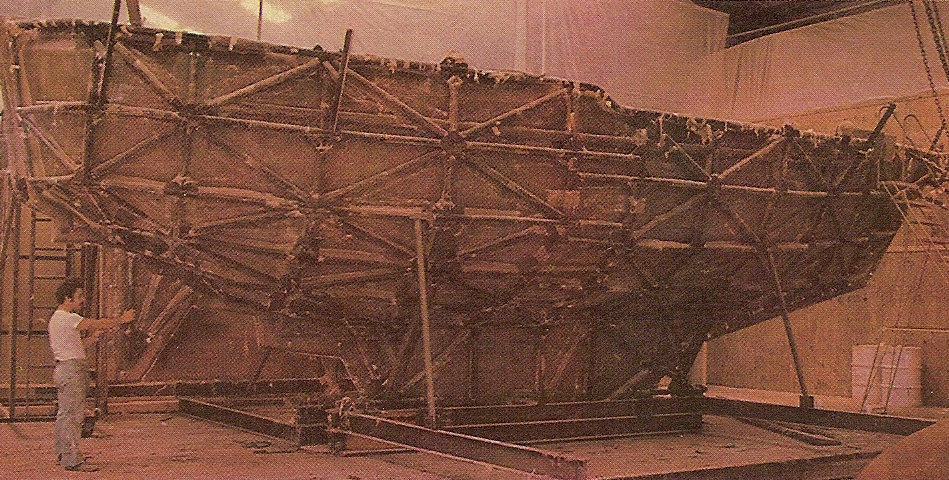
The CSY 44 Mold
The Hull Layup
No mold can be any
better than the amount of care and time that is spent to properly clean
and wax it between the production of one part and the next one.
Too little wax or wax unevenly applied can spell disaster for a new hull
or the mold itself!
This is another truism and a very important one.
The first layer to go into the mold is the gel coat. There are 2 types
of gel coat, organic and inorganic. The latter, which CSY uses, is 1/3
more expensive. It dries harder, and it holds its color and high gloss
longer. It's so easy for a manufacturer to skimp here, but you won't
discover it for at least a couple of years.
The gel coat is laid down carefully from 18 to 25 thousandths of an inch
thick. If it is too thick it will cure unevenly. If it is too thin, it
will 'craze' or 'alligator'. Care and precision are essential, as in
every other part of the production of anything, including a boat.
Next comes the layering or laminating of the fiberglass in the form of
roving and mat carefully rolled out in resin. The right way to create
these layers is the slow way. Step by step, layer by layer, with plenty
of time between applications for the laminate to set and to be sanded
smooth.
At the CSY Yacht Corporation, we use twice the number of layers of mat
and roving than is recognized by the industry as an "adequate" layup. At
the turn of the bilge, our layup approaches two inches.
Why so thick? For that once-in-a-lifetime moment when a stronger hull
can save the boat--and your life. A hull is the foundation of a boat,
the same as it is with a house. A thick hull is a strong foundation
which translates into bulkheads, doors and engine beds that don't shift,
and always fit.
Guidelines set by the Society of Naval Architects consider an acceptable
flexural strength for a fiberglass hull to be between 25 and 20 thousand
pounds per square inch (psi). CSY's hulls test to an average of almost
36 thousand psi because of the time and care and additional materials
that go into the layup.
The Deck
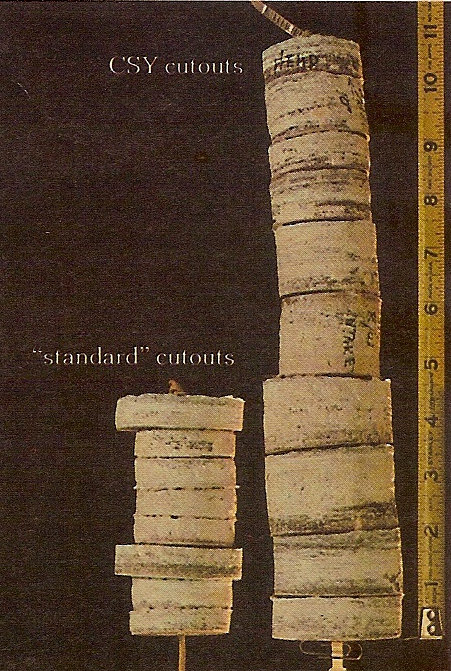 The
decking on all CSY yachts is solid glass laid up to the thickness of
most hulls. This is a great deal stronger than any sandwich type
construction of balsa or foam or plywood squares. Exceptionally durable.
It won't rot, it won't mildew, it won't leak.
The
decking on all CSY yachts is solid glass laid up to the thickness of
most hulls. This is a great deal stronger than any sandwich type
construction of balsa or foam or plywood squares. Exceptionally durable.
It won't rot, it won't mildew, it won't leak.
Joining the deck to the hull is a crucial operation because no matter
how durable both pieces are, if the joint is weak or improperly
prepared, you're in for trouble. What has to be remember about a
hull-to-deck joint is that it has to 1. be flexible. 2. it has to have a
mechanical hold to keep the deck and the hull together as the flexural
stresses of each differ. 3. if possible and most important is that the
joint can accommodate 1. and 2. and still keep your boat together,
forever, and still keep the boat dry.
Here is how CSY does it. First a flexible sealant, 5200 by 3M, is placed
in the joint when the deck is placed on the hull. Then #4 stainless
steel screws are set every 8 inches to keep the alignment of the deck
and the hull. Next, heavy 5/16" stainless steel bolts with lock washers
and nuts, secure the deck to the hull on 8" center. Over this a teak toe
rail is placed which is also screwed through the joint every 12 inches.
If there is a better hull-deck bond in the industry, we don't know about
it.
Hatches: All CSY decks are designed with high 4" coamings to receive all
hatches. Then we build heavy hatches, which rest on gaskets on top of
the coamings to make a seal. Even if the gasket doesn't seal or
deteriorates, there has to be 4 inches of standing water on the deck
before a leak can begin, even if the hatch is not dogged down!
Thought has gone into the design of the CSY deck. And it pays off. It
pays off in safety, and it pays off in dryness, which has to be the most
important element in comfort on any boat.
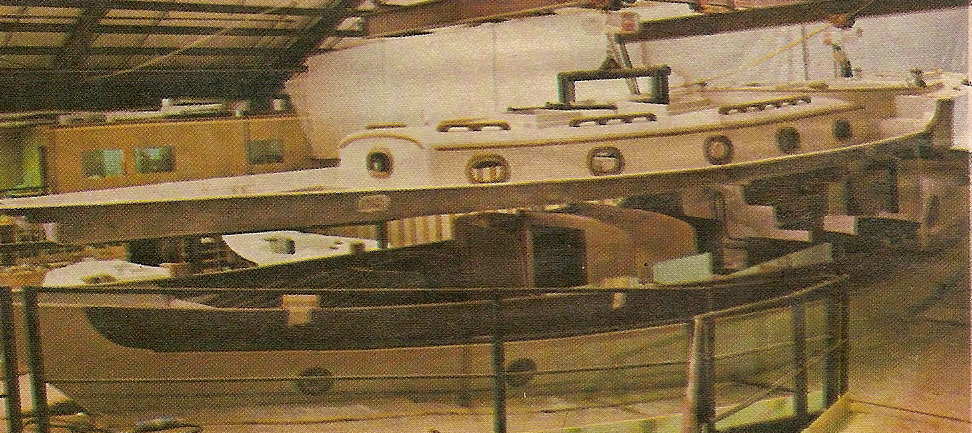
The Final Check
Constant quality control is the most crucial consideration in the
process of building a boat to a high standard.
Our boats are built on nine stations with four days on each station. At
the end of each day, there is a quality inspection to assure everything
is being done to our standards. Then when the boat is ready to go out
the door, it is held up for an entire day for it's final pre-launch
inspection.
In the old days, no self-respecting boat builder would ever consider
delivering a boat that had not been given a thorough series of
in-the-water boat trials.
Today the boat buyer is lucky if his boat is even put in the water, let
alone sea-tested and checked out before it is delivered to him.
At CSY we're old fashioned.
Prior to delivery we take every yacht we build through a comprehensive
battery of trials, tuning the rigging, checking the sails, inspecting
for misalignments and discontinuities. We give the engine a 24 hour
check. We take her out for a test run under full sail and under power.
When all systems have been checked and rechecked, and the yacht is
deemed ready for delivery, the boat is turned over to the owner.
At this state, back in the good old days, the owner would conduct his
own "Owners Trial" or "Acceptance Trial", taking the boat out,
subjecting it to his own scrutiny and returning with any criticisms he
had for correction.
We welcome this old fashioned concern for excellence and encourage all
new owners to conduct their own personal sea trials.
It assures us that we are delivering a quality product, and assures you
of the same thing.
The Hardware - Blocks, Spars, and Rigging
We have tested hardware from A to Z in all conditions. We never
standardize on anything unless it works. We have everybody knocking on
our door to sell us their wares.
Our laboratory is our charter business. If it works there, we know it
will work on your boat. We only buy what we know will work and will
last, and that which we have tested.
Unlike most other manufacturers, we don't buy because of price. We buy
the best, regardless of price.
The Steering
Edson steering systems are standard aboard all cSY yachts. Edson uses
stainless steel chains as a driving mechanism, and then it changes over
to wire around sheaves to a quadrant attached to the rudder post. CSY
extends the rudder post and machiens the top of it so an emergency
tiller can be attached if one of the steering cables should let go.
Edson equipment uses steel needle bearings which give a smooth, good
"feel" in steering. For the wheel we prefer the Edson smooth, all
stainless steel destroyer wheel because it is corrosion proof and
trouble-free. But the final and most cruicial step is in the design and
the care in the installation of the system.
Storage
Good storage can make or break a boat for whoever has the job of keeping
things neat below. Here are just some of the storage facilities aboard
all CSY yachts. For each one on boat: 12"-18" of linear space in the
hanging lockers, 2 large bunk-sized drawers, a private drawer in the
head, bunk-side shelves. For keeping things together--dry storage for
bedclothes and pillows, instrument, book and chart storage, clothes
hampers in each head, extra linen storage, dry shoe storage, tool
storage drawer, odds and ends drawer, 4 or 5 galley drawers, space under
the sink for storage, a pots and pans locker, dish locker, a glasses and
bowls locker, bug and odor-free garbage storage. Spice rack, liquor
cabinet, cockpit cubbyholes (for winch handles, etc) Bib, big sail
lockers to hold extra sails, fenders, cushions, lines, outboard,
anchors, everything. An on-deck 'dirty' locker. A beer cooler next to
the helmsman in the cockpit. Vented propane storage (3 month supply).
Split anchor rode storage (250' of line plus chain per bin). There is
room aboard to store 3 full weeks of provisions (3 weeks of perishables,
3 weeks worth of ice, 3 weeks of frozen food--in a mechanical
refrigerator. The list goes on and one. Planning ample storage means a
comfortable home afloat.
Ventilation &
Dryness
Without proper ventilation and dry design, mildew and moisture can make
your life miserable. "Proper" ventilation doesn't mean "adequate"
ventilation, but super ventilation. There isn't an enclosed space on any
of our yachts that can't have both opening ports and one or more
overhead hatches in addition to companionways. Count the possibilities
for opening hatches and opening ports on any CSY yacht and compare with
any yacht you may be contemplating. There is no comparison.
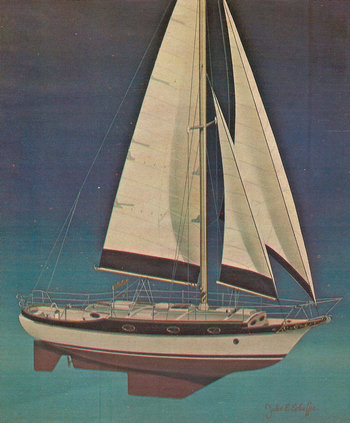 Liveability
Liveability
All CSY yachts are designed to be lived aboard for long periods of time.
Even forever, in comfort and privacy. Just what is comfort aboard a
yacht? 6" cushions instead of the usual 3" or 4" ones. Hatches with high
lips, means a dry boat. Can you think of anything more important?
Oversized beds, not bunks, designed fore and aft, not athwartships. A
minimum of 6'4" headroom, going to 6'7". A slow running diesel,
insulated and out of the living areas, with a quiet exhaust system. A
large, convenient, safe galley. Big heads. Ample showers with hot and
cold pressure water. Fuel and water tankage so you don't have to worry
about it for weeks at a time. Broad and uncluttered decks. Battery
condition guages. An electric windlass for hauling in the anchor. A
circuit breaker panel for all electrics. An electric bilge pump backed
by a big hand pump that doesn't require the endurance of Charles Atlas
to pump it. Liveability, in short, comfort, is one of the things that
makes you really love your boat. She's designed and built to live aboard
for extended periods away from any base of supply.
Low Maintenance and Durability
Low maintenance and durability are determined by the quality and kind of
construction and the selection of equipment that go into a yacht. But
design plays its role too.
A totally accessible engine area is fundamental--so the engine can be
easily worked on or removed without tearing the boat apart.
Electrical wiring should be out of the bilge, accessible and coded to
know what goes to which.
Water tanks should be designed with large cleanout and access plates.
The bilge should be deep with a large capacity and gel coated for easy
cleaning. Chain plates should be easily accessible for inspection and
repair. All bolts through the deck easily accessible from both sides
with backup plates.
Lets face it. As the world's largest charter boat organization, we have
to care about maintenance. And we build for it.
Safety
CSY has put a lot of thought into the design of safety features. We have
eliminated steep, high ladders at the companionways. No matter where you
stand in a CSY yacht, there is a handhold within arms reach. In addition
to effective, restorable non-skid surfaces, CSY yachts feature deep
bulwarks forward to prevent sliding off the deck in high seas. They also
feature good deck and cockpit lighting for night cruising. Plus a
well-designed quick draining cockpit.
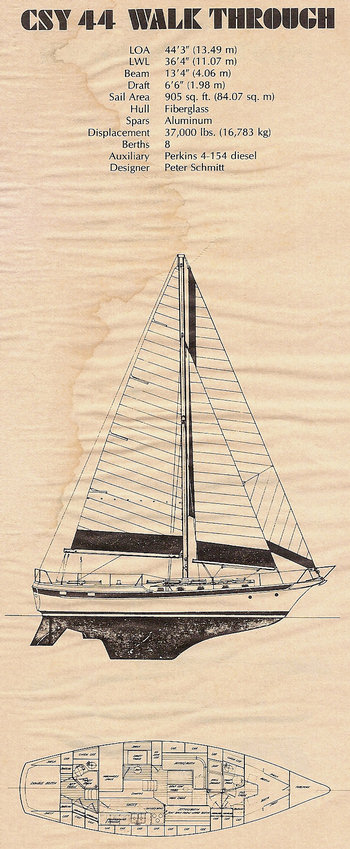 On
the New CSY 44 Walkthrough
On
the New CSY 44 Walkthrough
We have stated many
times our preference of no walk-through in the mid-cockpit
configuration, and have so stated in our book, the CSY Guide to Buying a
Yacht, with our reasons. However, we aren't everybody and
everybody should have a choice. Heretofore, we have only offered the
alternative. Now we offer the choice of a walk-through model which
corrects what we object to the most in a walk-through, an ugly, ungainly
boat.
Peter Schmitt has managed to come up with a really beautiful design by
raising the saloon, minimizing the long climb to and from the cockpit.
It also adds the extra dimension of large windows in the saloon, which
add the light and airiness rarely found in this configuration.
To be sure, some storage and tankage has been sacrificed as in any
walk-through. But this is trade for an extra large galley and chart
table, and the inside connection of the aft and forward sections of the
boat. This is for those who spend a lot of time living inside their
boat.
The CSY 44 Walk-Through sails well. We know that because she is built on
exactly the same proven hull as our other CSY 44 models. She is built to
the same heavy specifications as her sister, with bronze ports, bronze
hardware below, stainless steel propane stoves, stainless steel hardware
on deck, extra-heavy rigging, and the Perkins 4-154 diesel--everything
that places a CSY yacht head and shoulders above any other yacht.
CSY Guide to Buying a Yacht
One of the unique ways that CSY sold their high-quality yachts was via educational brochures (as above). The best one is "CSY Guide to Buying a Yacht". At 132 pages, it covered everything a prospective buyer should think about when buying a new boat. Download it here (26 MB)
Bareboat charter pioneer remembered
Jack Van Ost Obituary, May 2006
Jack Van Ost, a New Jersey dentist, father of eight and pioneer in yacht chartering, has died in Sun City Center, Fla., at the age of 83.
Van Ost, founder of Caribbean Sailing Yachts, opened one of the first Caribbean charter bases, operating first out of Red Hook, USVI, then Tortola, BVI a year later. CSY started its first winter charter season in 1967 with 16 Chris-Craft Capri 30s. At its height in 1981, the company was chartering 186 sailboats from bases in the Florida Keys, Roatan in Honduras, the Bahamas, Tortola and St. Vincent in the Grenadines. He introduced many innovations now common in yacht chartering: standardized and easy-to-maintain fleets, boats designed for charter, provisioning, owner lease-back programs, a sailing school, a manual to familiarize customers with boat systems and cruising grounds, and a system for qualifying clients to charter a boat.
"He was the father of the bareboat industry,"
says Butch Ulmer, president of Ulmer Sails, of City Island, N.Y., who
supplied most of CSY's sails. "He was the guy who started it all. It was his
vision."
Van Ost conceived the idea of a charter fleet made up of identical boats —
uniformly maintained and equipped and operated from a base with a marina
(and later a small hotel) — after a particularly memorable Bahamas charter.
In 1976 Van Ost and his team designed with Peter Schmitt the CSY 44, a boat Van Ost wanted to be the ultimate cruising boat — tough, fast, comfortable, seaworthy — the culmination of all he'd learned about the demands of cruising. Thirty years later it still is considered one of the great cruising boats, but the design led to a decision that would ultimately sink CSY. Unable to find a builder who could produce a boat of sufficient quality at the price he wanted, Van Ost decided to build the boat himself in Tampa.
CSY quickly became the sixth-largest sailboat builder in the country, building 400 boats from 1977-'81, but Robert Van Ost said a one-two punch of 20-percent interest rates and a half-million-dollar deficit at the outset of the venture dogged it to the end.
Walsh said, too, "We were a bunch of sailors building boats. We needed more bean counters. We sold the first 70 boats for $68,000 [apiece] and they cost $73,000 to build."
CSY Yacht Corp. sucked so much money out of the charter business that it never recovered, Robert Van Ost said. The boat building operation closed in 1981, and 10 years later the charter company closed, handing over its remaining bookings to The Moorings, he said.

